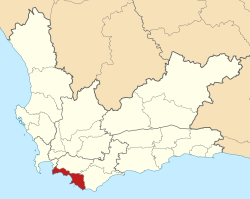History
By the end of the apartheid era in the early 1990s there were various local authorities established on a racially segregated basis in the area that was to become Overstrand. Municipal councils were elected by the white residents of the towns of Betty's Bay, Kleinmond, Onrusrivier, Hermanus, Stanford, and Gansbaai; and local councils by the white residents of the villages and holiday resorts: Pringle Bay, Rooi-Els, Vermont, Sandbaai, Pearly Beach, De Kelders, Kleinbaai, and Franskraalstrand. The coloured areas of Kleinmond, Stanford, Hawston, Mount Pleasant and Gansbaai were governed by management committees subordinate to the white municipalities; and the black area of Zwelihle was governed by a town council established under the Black Local Authorities Act. Rural areas were served by the Overberg Regional Services Council.
While the negotiations to end apartheid were taking place a process was established for local authorities to negotiate voluntary mergers. In January 1993 the Municipality of Kleinmond merged with its management committee to form a single Municipality for the Area of Kleinmond; and the Municipality of Gansbaai merged with its management committee and the local councils of De Kelders, Kleinbaai, Franskraalstrand and Pearly Beach to form a single Municipality for the Area of Gansbaai. In January 1994 the Betty's Bay Municipality merged with the local councils of Pringle Bay and Rooi-Els to form the Hangklip Municipality.
After the national elections of 1994 a process of local government transformation began, in which negotiations were held between the existing local authorities, political parties, and local community organisations. As an outcome of these negotiations, transitional local councils (TLCs) were created and the existing local authorities were dissolved. In December 1994, the Greater Hermanus TLC replaced the Hermanus Municipality, the Onrusrivier Municipality, the Zwelihle Town Council, the management committees of Hawston and Mount Pleasant, and the local councils of Vermont and Sandbaai. In the same month the Gansbaai TLC replaced the Municipality for the Area of Gansbaai. In January 1995 Hangklip/Kleinmond TLC replaced Hangklip Municipality and the Municipality for the Area of Kleinmond, and the Stanford TLC replaced the Municipality of Stanford and the Stanford Management Committee.
The transitional councils were initially made up of members nominated by the various parties to the negotiations, until May 1996 when elections were held. At these elections the Overberg District Council was established, replacing the Overberg Regional Services Council. Transitional representative councils (TRCs) were also elected to represent rural areas outside the TLCs on the District Council; the area that was to become Overstrand included the Hermanus TRC as well as parts of the Caledon and Bredasdorp TRCs.
At the local elections of December 2000 the TLCs and TRCs were dissolved, and the Overstrand Municipality was created as a single local authority incorporating both rural and urban areas. It was considered a stronghold of the now defunct New National Party (NNP), which had held (sometimes concealed) majorities of two thirds in the predecessor municipalities after the November 1995 municipal elections, which were the first since South Africa had its first multi-racial elections.
After the 2000 election, Willie Smuts, previously mayor of Hangklip-Kleinmond Municipality, was elected mayor, representing the Democratic Alliance (DA), before he defected along with seven other DA councillors to the New National Party (NNP) after the October 2002 floor-crossing window. The NNP then formed a coalition with the African National Congress (ANC) when the council was reconstituted. After the September 2004 floor crossing Smuts then crossed the floor to the ANC along with most NNP councillors which gave the ANC an outright majority in the town for the first time.
At the time of the March 2006 local elections the eastern boundary with Cape Agulhas Municipality was moved west, with Cape Agulhas taking over rural land to the north and south of Elim. In the 2006 elections the DA won an outright majority of 10 seats in the 19-seat council. Willie Smuts was replaced as Mayor by Theo Beyleveldt. The DA consolidated its hold in the council following the September 2007 floor crossing window which saw the party gain an eleventh seat from the African Christian Democratic Party (ACDP). The ANC lost a seat to the newly formed National People's Party, as did the Independent Democrats, whose only representative in the Overstrand Council crossed over.
In the May 2011 local elections, the DA again won Overstrand outright, taking fifteen of the twenty-five seats on the council, with the ANC taking nine and the National Independent Civic Organisation one.
In the August 2016 local elections, the DA increased its majority to sixteen of twenty-five seats, with the ANC taking eight and the Economic Freedom Fighters (EFF) taking one.
In a by-election in December 2020, the Land Party won a seat from the ANC [7]
In the November 2021 local elections, the council was expanded to twenty-seven seats. The DA won seventeen seats, the ANC four, the Land Party and the Freedom Front Plus two each, and the EFF and the ACDP one each.






